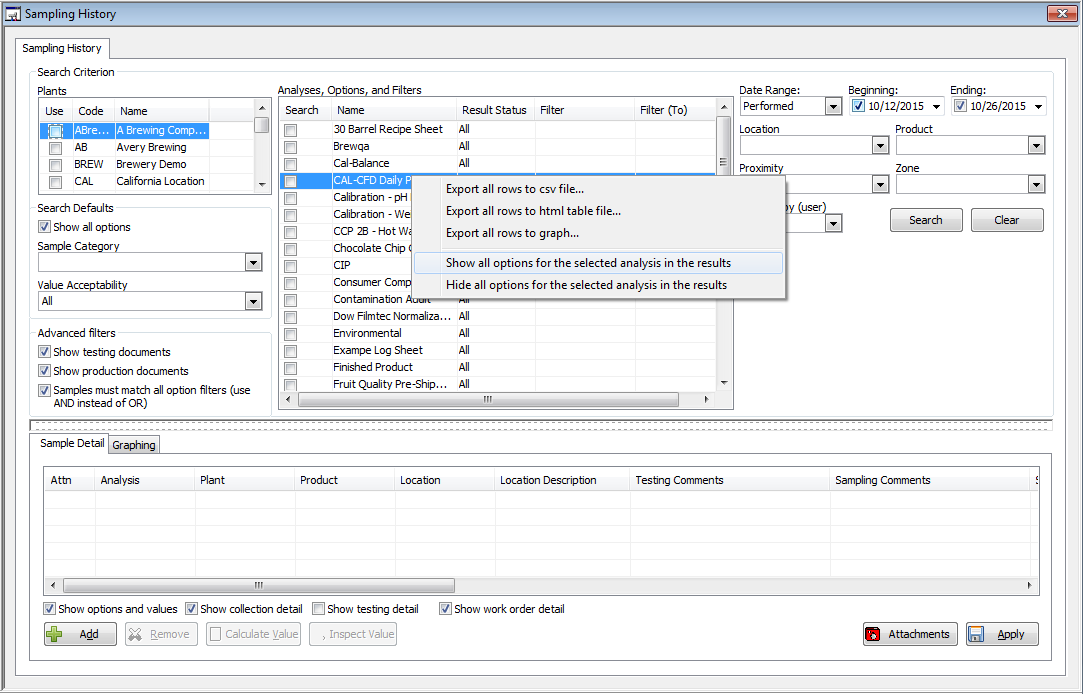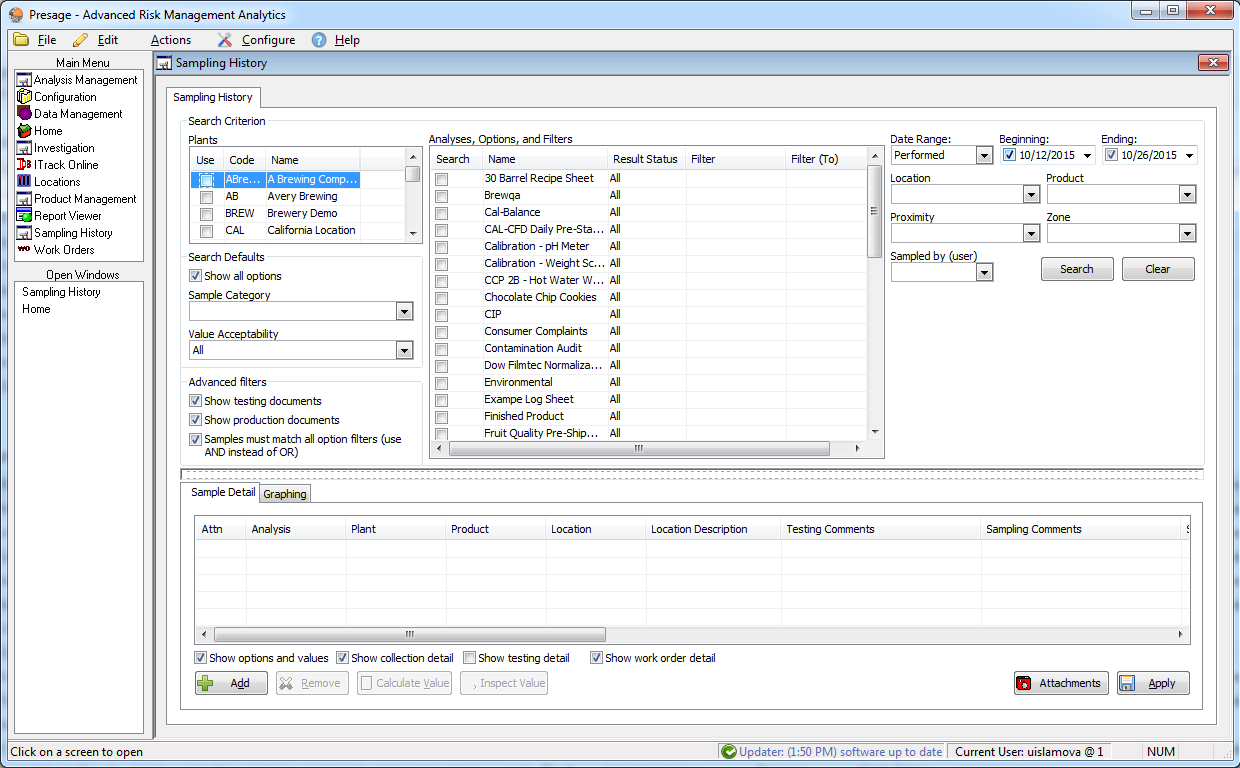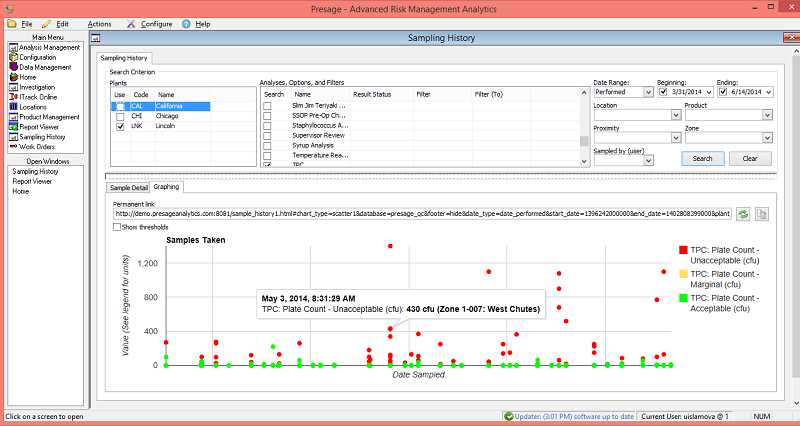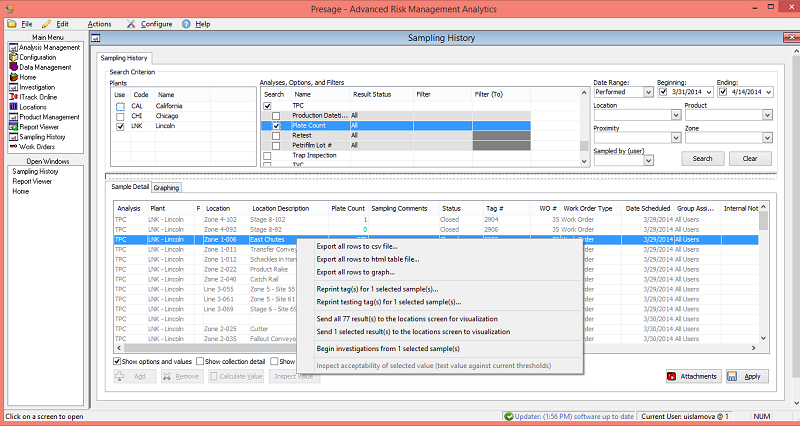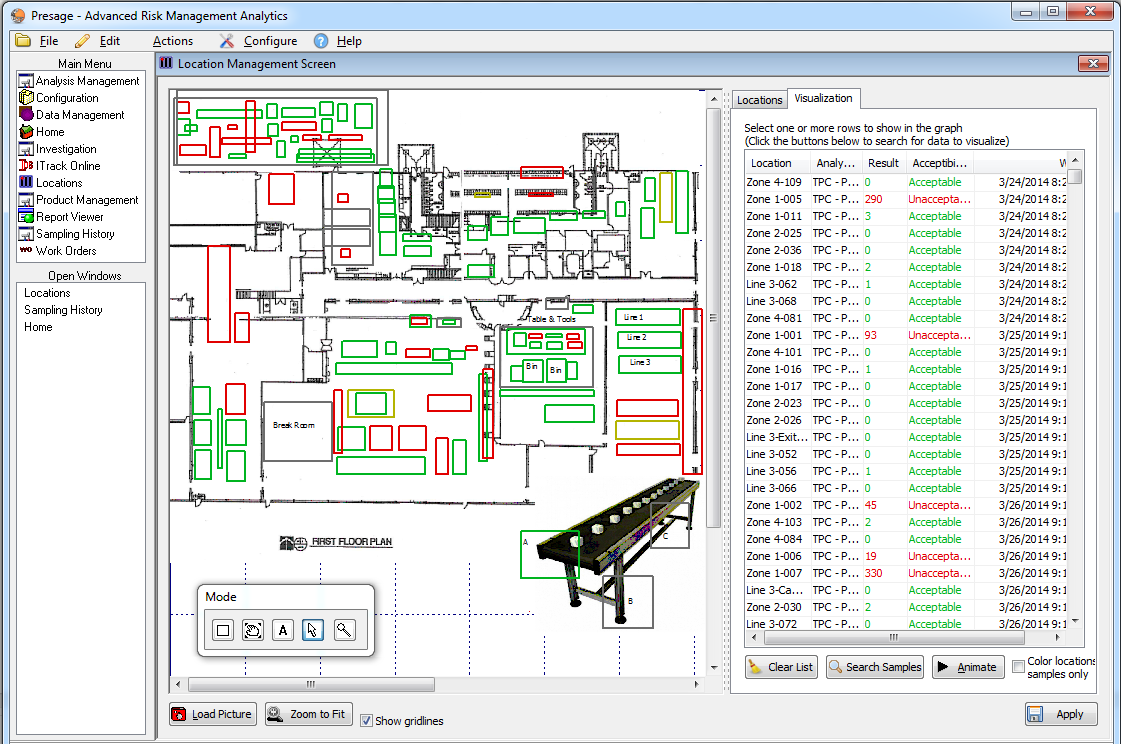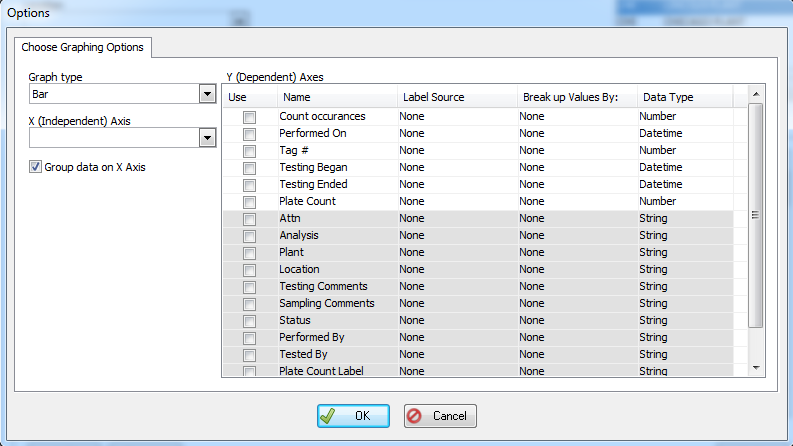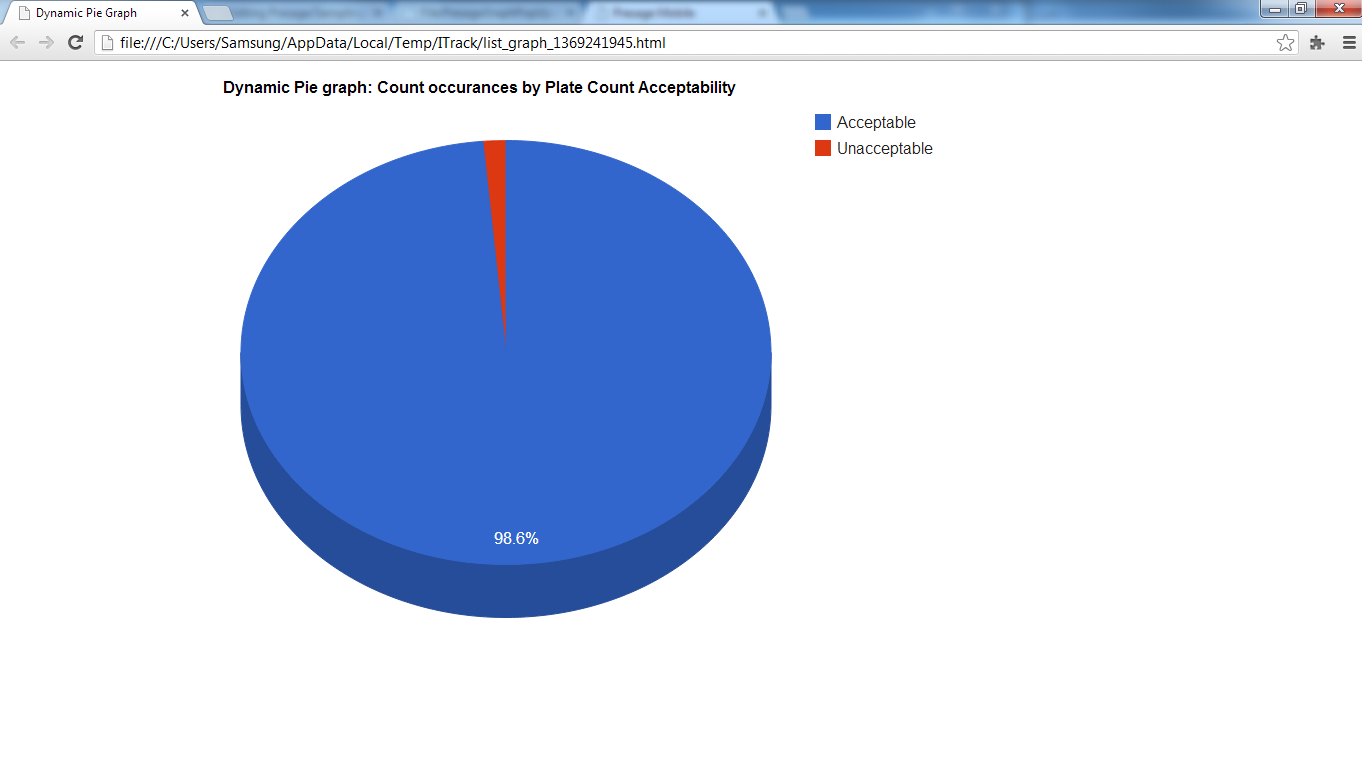Difference between revisions of "Presage/User Guide/Sampling Screen"
(Created page with "==Sampling History Tab== This screen is used as a search engine which makes it easy to find past sampling information. Click on the link below to watch a VIDEO TUTORIAL for th...") |
|||
| Line 8: | Line 8: | ||
Check the box(es) next to the plant(s) | To perform a search: | ||
1. Check the box(es) next to the plant(s) if different than the plant you logged in to; | |||
2. Check Analysis name(s) (which drops down the list of options) | |||
OR | |||
Select ''Sample Category'' from the drop-down which is under the ''Plants'' section. This will automatically check all the analyses with the selected category. | |||
3. Check Option(s) which are labels for the data collected. | |||
NOTE: If you check the '''Show all options''' box, the options will be checked automatically once analyses are selected, so you do not need to go through and check options one by one. | |||
NOTE: If you want to check all options under a ''specific'' analysis, right-click on the analysis label and select '''Show all options for the selected analysis in the results'''. | |||
[[File:Showalloptions PresageSH.png|center]] | |||
4. Plug in the variables in the filters provided on the left: date range, location, product, user, proximity and/or zone. | |||
5. Click Search. | |||
'''Sampling Category''' | |||
Selecting a ''Sampling Category'' will automatically check the boxes of all analyses associated with the category. | |||
'''Value Acceptability''' | |||
Select a ''Value Acceptability'' to filter data to certain statuses such as Unacceptable, Acceptable, Marginal, etc. | Select a ''Value Acceptability'' to filter data to certain statuses such as Unacceptable, Acceptable, Marginal, etc. | ||
| Line 18: | Line 51: | ||
Click ''' | '''Show testing documents''' vs '''Show production documents''' | ||
''Show testing documents'' brings up data that was collected in the '''Sample Detail''' section of the work order screen. All data except batching related data is collected there. | |||
'''Show production documents''' is associated with the data collected in the '''Production''' section of the work order screen. This is where data specific to batching is collected if you are using the recipe and batching features of Presage. | |||
'''Samples must match all option filters (use AND instead of OR)''' | |||
Differentiating between AND and OR | |||
'''OR''' (default): Show results for Analysis A - option A over 15 ‘OR’ Analysis A - Option B Unacceptable. '''Results match either condition 1 OR condition 2, or both.''' | |||
'''AND''' (check box): Show results for Analysis A - option A over 15 ‘AND’ Analysis A - Option B Unacceptable. '''Both conditions MUST be met.''' | |||
'''Filter''' & '''Filter (To)''' | |||
Setting a number in the ''Filter'' field | |||
If you set ‘15’ in the ''Filter'' field, sample results 15 AND UP show up. | |||
OR if you set, ‘15’ in the ''Filter (To)'' field, search will pull all sample results 15 AND UNDER. | |||
NOTE: Click on the column header to sort the results. | |||
To do an exact search, set ‘15’ in both ''Filter'' and ''Filter (To)'' fields. | |||
Revision as of 13:16, 26 October 2015
Sampling History Tab
This screen is used as a search engine which makes it easy to find past sampling information.
Click on the link below to watch a VIDEO TUTORIAL for the Sampling History screen.
Search Data in Sampling History
To perform a search: 1. Check the box(es) next to the plant(s) if different than the plant you logged in to;
2. Check Analysis name(s) (which drops down the list of options)
OR
Select Sample Category from the drop-down which is under the Plants section. This will automatically check all the analyses with the selected category.
3. Check Option(s) which are labels for the data collected.
NOTE: If you check the Show all options box, the options will be checked automatically once analyses are selected, so you do not need to go through and check options one by one.
NOTE: If you want to check all options under a specific analysis, right-click on the analysis label and select Show all options for the selected analysis in the results.
4. Plug in the variables in the filters provided on the left: date range, location, product, user, proximity and/or zone.
5. Click Search.
Sampling Category
Selecting a Sampling Category will automatically check the boxes of all analyses associated with the category.
Value Acceptability
Select a Value Acceptability to filter data to certain statuses such as Unacceptable, Acceptable, Marginal, etc.
Show testing documents vs Show production documents
Show testing documents brings up data that was collected in the Sample Detail section of the work order screen. All data except batching related data is collected there.
Show production documents is associated with the data collected in the Production section of the work order screen. This is where data specific to batching is collected if you are using the recipe and batching features of Presage.
Samples must match all option filters (use AND instead of OR)
Differentiating between AND and OR
OR (default): Show results for Analysis A - option A over 15 ‘OR’ Analysis A - Option B Unacceptable. Results match either condition 1 OR condition 2, or both.
AND (check box): Show results for Analysis A - option A over 15 ‘AND’ Analysis A - Option B Unacceptable. Both conditions MUST be met.
Filter & Filter (To)
Setting a number in the Filter field
If you set ‘15’ in the Filter field, sample results 15 AND UP show up.
OR if you set, ‘15’ in the Filter (To) field, search will pull all sample results 15 AND UNDER.
NOTE: Click on the column header to sort the results.
To do an exact search, set ‘15’ in both Filter and Filter (To) fields.
Once historical data is pulled up on the sampling screen, four things can be done:
1) Sent to the scatter graph for trending as explained above. 2) Sent to the Location Visualization which shows the sample acceptability over the plant layout. 3) Sent to the Graphing to do more complex charting. 4) Exported to a .csv file.
Click on the column title on the table, to order the data by a certain criteria. For example, click on the Performed On to see results in chronological order of date performed.
To restart the search filter, click Clear. It will clear out all filters entered previously and drop-down the search filter panel.
Uncheck the 'Show collection detail' box to hide 'Performed On' and 'Performed By' columns. These fields are auto-populated in the Work Order screen as soon as results are entered.
Uncheck the 'Show testing detail' box to hide the 'Testing Began', 'Testing Ended', and 'Tested By' columns. These fields are related to incubation of samples.
Uncheck the 'Show work order detail' box to hide the 'WO#', 'Work Order Type', 'Internal Notes', 'Sampling Instructions', 'Group Assigned', 'Date Created', 'Date Scheduled', and 'Date Due' columns. These are all work order level information.
Keep 'Show options and values' box checked.
To Trend Data:
Click the Graphing tab for a scatter graph for the criteria selected.
Select and edit criteria for the graph using the same panel as used with sampling history on the upper portion of the screen.
Hover over points to view details such as date, time, analysis, analysis option, location, etc.
Hover over a label in the map key to highlight the group of points which belong to that label.
To share the graph with a third party, click on the copy icon next to the browser link box on the mid-right side of the screen (it is the second button next to the browser link box). Then paste the link.
Check the Show Thresholds button to see the threshold lines on the graph.
Visualization
To see Location Visualization:
First, enter criteria and pull up historical data. Right-click on one of the rows. A dialog with multiple options pops-up. Click send all # results to the locations screen for visualization.
A new screen opens up. This is the Visualization tab under Locations Screen.
On the left display, locations are highlighted in green and red. Green locations are ones with acceptable counts, and red locations are ones with fail counts.
Highlight a row on the right and the corresponding location will be highlighted automatically on the left display and vice versa.
Order the Date Sampled column by clicking on the column title When. Click the first row and press the down-arrow on the keyboard to see a play-through of where the samples were taken in a chronological order.
Note: Every row can be ordered by clicking the column title.
Check the box Color locations based on selected samples only, and select a group of rows to see the colors only for those selected.
Graphing
To do more complex graphing:
Once historical data is pulled up on the sampling screen, this data can be graphed in multiple ways, in addition to the scatter graph.
First, enter criteria and pull up historical data. Right-click on one of the rows. A dialogue with multiple options pops-up. Click export all rows to graph.
The following dialog pops-up. Make selections, then click OK. The graph will open in a new browser page.
These graphs are saved in the local computer and cannot be shared with third-parties.
Export Data
Please, contact a Presage representative for exports.
